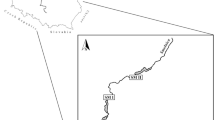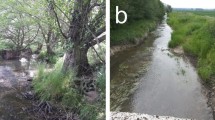Abstract
Up until the present, canals and ditches in Europe have been used to drain and thus devastate fens (lowland moors). However, in many cases, their function can be changed from drainage to irrigation and re-wetting of previously drained areas. These systems of canals and ditches are characteristic elements of the historically developed cultural landscape. Therefore, management and development plans should be oriented towards their continual maintenance. Despite the density of canals and ditches in many regions of Germany, especially of Eastern Germany, there are only a few studies to evaluate these systems of waterways, and an integrated approach towards their assessment has been totally absent. Existing approaches for typology and assessment of flowing waterbodies have been investigated in the Drömling Natural Park with regard to their applicability to such artificial canals and ditches. Special attention is given to the composition of macroinvertebrate fauna and the assessment of factors that determine it. Surprisingly, most water sectors have a high conservation value. High total numbers of species correlated well with the occurrence of endangered species. p ]Among the macroinvertebrates, limnophil and phytophil species were dominant, but rheophil fauna were also commonly present. This was caused by the intermediate status of canals and ditches, since they are neither completely flowing nor completely stagnant waterbodies. Habitat quality of these waters is determined by a small number of morphological parameters: bank steepness, depth of bottom, substrate diversity, hydraulic structures, and the structure of surroundings. In the framework of management and development measures, they should be maintained and improved for the future. To assess water quality, the Saprobic index and the Chemical index were appropriate, but for indication of trophic status, the Macrophyte-trophic index was adequate. Estimation of ecological integrity by a multimetric index using macroinvertebrates indicates that waterbodies are in a good status according to the demands of the European Water Framework Directive.
Similar content being viewed by others
References
Angermeier P.L. and Winston M.R. 1997. Assessing conservation value of stream communities: a comparision of approaches based on centres of density and species richness. Freshwater Biology 37: 699–710.
Bach E. 1984. Systeme zur Bewertung der Gewässerbeschaffenheit: USA-Schottland-Bayern (Chemischer Index). Gewässerschutz-Wasser-Abwasser 73: 299–311.
Beckett D.C. and Aartilla T.P. 1992. Contrasts in density of benthic invertebrates between macrophyte beds and open littoral patches in Eau Galle Lake, Wisconsin. American Midland Naturalist 117: 77–90.
Bellmann H. 1993. Libellen Beobachten - Bestimmen. Naturbuch-Verlag, Augsburg.
Böhmer J., Rawer-Jost C. and Kappus B. 1999. Ökologische Fließgewäasserbewertung. In: Steinberg, Calmano, Klapper, Wilken (eds), Handbuch Angewandte Limnologie Vol. 2, Ecomed, Landsberg, pp. 20–23.
Boon P.J. 2000. The development of integrated methods for assessing river conservation value. Hydrobiologia 422/423: 413–428.
Brandtstetter C.M. and Kapp A. 1995. Die Schwimmkäfer von Vorarlberg und Liechtenstein. 2. Bd. 310 S, Verl. des Ersten Vorarlberger Coleopterol. Ver.
Braukmann U. 1987. Zoozönologische und saprobiologische Beiträge zu einer allgemeinen regionalen Bachtypologie. Archiv für Hydrobiologie. Beih. Erg. Limnol. 355 S.
Buchwald R., Gerken B., Siedle K. and Sternberg K. 1984. Übersicht über die Libellenvorkommen in Baden-Würtemberg mit kurzer Charakteristik des Fortpflanzungsgebietes und Angaben zur Verbreitung. Libellula 3: 101–110.
Diederich A., Neumann D. and Borcherding J. 1995. Flora und Fauna in Gräben einer niederrheinischen Auenlandschaft - Auswirkungen von Grabenräumungen. Natur u. Landschaft 70: 263–268.
DIN 38410 Teil 2, 1991. Biologisch-ökologische Gewässeruntersuchung (Gruppe M). DEV 24. Lief. Beuth Verlag, Berlin Wien Zürich.
Donath H. 1989. Verbreitung und Ökologie der Zweigestreiften Quelljungfer, Cordulegaster boltoni (DONOVAN 1807), in der DDR (Insecta, Odonata: Cordulegasteridae). Faunistische Abhandlungen des Museums für Tierkunde Dresden16(6): 97–106.
Foster G.N., Foster A.P., Eyre M.D. and Bilton T. 1990. Classification of water beetle assemblages in arable fenland: ranking of sites in relation to conservation value. Freshwater Biology 22: 343–354.
Freude H., Harde K.W. and Lohse G.A. 1971. Die Käfer Mitteleuropas, Vols. 3 and 6. Verl. Goecke & Evers, Krefeld. 443.
Freude H., Harde K.W. and Lohse G.A. 1979. Die Käfer Mitteleuropas, Vols. 3 and 6. Verl. Goecke & Evers, Krefeld.
Geyer A. and Mühlhofer G. 1997. Bewertung von Flächen für die Belange des Arten - und Biotopschutzes anhand der Tagfalterfauna. VUBD-Rundbrief 10: 7–11.
Janse J.H. and van Puijenbroeck P.J.T.M. 1998. Effects of eutrophication in drainage ditches. Environmental Pollution 102: 547–552.
Jedicke E. 1997. Die Roten Listen: Gefährdete Pflanzen, Tiere, Pflanzengesellschaften und Biotope in Bund und Ländern. Verlag Eugen Ulmer, Stuttgart.
Joosten J.H.J. 2001. Wise use of mires and peatlands - background and principles. Ph.D. Dissertation. Ernst-Moritz-Arndt-University, Greifswald.
Karr J.R. and Chu E.W. 2000. Sustaining living rivers, Hydrobiologica 422/423: 1–14.
Kaule G. 1991. Arten-und Biotopschutz. UTB Große Reihe. Verlag Eugen Ulmer, Stuttgart.
Langheinrich U. and Lüderitz V. 1997. Einflußfaktoren auf die Güte der Oberflächengewässer im Drömling. Wasserwirtschaft 87: 2–6.
Langheinrich U. and Lüderitz V. 1998. Planungen zur Entwicklung des Gewässersystems im Drömling. Wasserwirtschaft 88: 178–182.
Langheinrich U., Senst M., Braumann F. and Lüderitz V. 1998. Probleme der Niedermoorregeneration im Naturpark Drömling. Natur und Landschaft 73: 450–455.
LAU (Landesamt für Umweltschutz), 1998. Fließgewässerprogramm Sachsen-Anhalt. Landesamt für Umweltschutz. Halle.
LfU (Landesanstalt für Umweltschutz Baden-Württemberg), 1992. Handbuch Wasser 2: Biologisch-ökologische Gewässeruntersuchung. Arbeitsanleitung Loseblattsammlung, Stuttgart.
Lüderitz V., Gläser J., Kieschnik A. and Dörge E. 1996. Anwendung und Weiterentwicklung ökomorphologischer Kartierungs - und Bewertungsverfahren an der Selke und ihren Nebengewässern. Arch. f. Naturschutz und Landschaftsforschung 35: 15–31.
Lüderitz V. and Hentschel P. 1999. Umgestaltungsmaßnahmen am Landeskulturgraben bei Dessau - ein Beispiel für den Umgang mit anthropogenen Fließgewässern. Naturschutz und Landschaftsplanung 31: 18–22.
Marmonier P., Claret C. and Dole-Olivier M.-J. 2000. Interstitial fauna in newly-created floodplain canals of a large regulated river. Regulated Rivers: Research and Management 16: 23–26.
Melzer A. 1988. Der Makrophytenindex - Eine biologische Methode zur Ermittlung der Nährstoffbelastung von Seen. Habilitationsschr., Technsche. Universität München.
Melzer A. 1993. Die Ermittlung der Nährstoffbelastung im Uferbereich von Seen mit Hilfe des Makrophytenindex. Münchener Beiträge zur Abwasser-, Fischerei - und Flussbiologie 47: 156–172.
MRLU (Ministerium für Raumordnung, Landwirtschaft und Umwelt), 1997. Umweltbericht Sachsen-Anhalt. Ministerium für Raumordnung, Landwirtschaft und Umwelt, Magdeburg.
Moog O. 1995. Fauna Aquatica Austriaca.-Katalog zur autökologischen Einstufung aquatischer Organismen Österreichs.-Wasserwirtschaftskataster, Bundesministerium für Land - und Forstwirtschaft, Wien.
Müller J. and Walter S. 1993. Die Insekten. In: Der Naturpark Drömling.-Naturschutz im Land Sachsen-Anhalt, Sonderheft, pp. 41–46.
Painter D. 1999. Macroinvertebrate distributions and the conservation value of aquatic Coleoptera, Mollusca, and Odonata in the ditches of traditionally managed and grazing fen at Wicken Fen, UK. Journal of Applied Ecology 36: 3–48.
Passauer B., Meilinger P., Melzer A. and Schneider S. 2002. Does the structural quality of running waters affect the occurence of macrophytes? Acta hydrochimca et hydrobiologica 30(4): 197–206.
Pauls S., Feld C., Sommerhäuser M. and Hering D. 2002. Neue Konzepte zur Bewertung von Tieflandbächen und - flüssen nach Vorgaben der EU Wasser-Rahmenrichtlinie. Wasser & Boden 54/7+8, pp. 70–77.
Pitsch T. and Weinzierl A. 1992. Rote Liste gefährdeter Köcherfliegen (Trichoptera) Bayerns.-Schriftenreihe des Bayerischen Landesamtes für Umweltschutz 111: 201–205.
Ramsar 1999. Recommendation 7.1: a global action plan for the wise use and managemant of peatlands. www.ramsar.org/key.
Reichhoff L. 1996. Pflege - und Entwicklungsplan Drömling.-Ministerium für Raumordnung, Landwirtschaft und Umwelt, Magdeburg.
Rothmaler W. 1981. Exkursionsflora. Gefäßpflanzen.Volk und Wissen Verlag, Berlin.
Schneider S. 2000. Entwicklung eines Makrophytenindex zur Trophieindikation in Fließgewässern. Dissertation, Technische Universität München.
Schneider S. and Melzer A. 2003. The Trophic Index of Macrophytes (TIM) - a New Tool for Indicating the Trophic State of Running Waters. International Review on Hydrobiology 88(1): 49–67.
Schmedtje U. and Kohmann F. 1992. Bestimmungsschlüssel für die Saprobier-DIN-Arten (Makroorganismen). Bayer. Landesamt f. Wasserwirtschaft. München.
Schmedtje U. 1996. Ökologische Typisierung der aquatischen Makrofauna. Bayer. Landesamt f. Wasserwirtschaft, München.
Schönemund F. 1930. Eintagsfliegen oder Ephemeroptera. In: Dahl F. (Hrsg.), Die Tierwelt Deutschlands, 19, 6. Fischer-Verlag, Jena.
Schubert R., Hilbig W. and Klotz S. 1995. Bestimmung der Pflanzengesellschaften Mittel - und Nordostdeutschlands. Gustav-Fischer-Verlag, Jena, Stuttgart.
Shannon C.E. and Wiener W. 1949. The Mathematical Theory of Communication. The University of Illinois Press, Urbana, IL.
Sommerhäuser M. and Schuhmacher H. 2003. Handbuch der Fließgewässer Norddeutschland. Ecomed, Landsberg.
Studemann D., Landolt P., Satori M., Hefti D. and Tomka I. 1992. Ephemeroptera. Insecta Helvetica Fauna 9, Schweizerische Entomologische Gesellschaft.
Succow M. and Jeschke L. 1990. Moore in der Landschaft 2nd ed. Frankfurt (Main).
Suhling F. 2000. Die Libellenfauna des Drömling. Ber. der Aktion Drömlingschutz, Wolfsburg.
Täuscher L. 1998. Kleine Fließgewässer und Entwässerungsgräben in Nordostdeutschland als Refugialbiotope für seltene und gefährdete Mikro-und Makrophyten und ihre Nutzung zur Bioindikation. 19. Jahrestagung BONITO, Feldberg.
Tobias W. and Tobias X. 1981. Trichoptera Germanica. Bestimmungstafel für die deutschen Köcherfliegen.Teil I.Imagines. Cour. Forschungsinstitut Senckenberg Frankfurt a. M. 49: 1–672.
Vannote R.L., Minshall G.W., Cummins K.W., Sedell J.R. and Cushing C.E. 1980. The river continuum concept. Canadian Journal of Fisheres and Aquatic Sciences 37: 130–177.
Waringer J. and Graf W. 1997. Atlas der österreichischen Köcherfliegenlarven. Facultas - Universitätsverlag., Wien.
Wegener U. 1998. Naturschutz in der Kulturlandschaft. Gustav-Fischer-Verlag, Jena.
Woodley S., Kay J. and Francis G. (eds.) 1993. Ecological Integrity and the Management of ecosystems. St. Lucie Press, Ottawa.
Author information
Authors and Affiliations
Corresponding author
Rights and permissions
About this article
Cite this article
Langheinrich, U., Tischew, S., Gersberg, R.M. et al. Ditches and canals in management of fens: opportunity or risk? A case study in the Drömling Natural Park, Germany. Wetlands Ecol Manage 12, 429–445 (2004). https://doi.org/10.1007/s11273-004-0700-y
Issue Date:
DOI: https://doi.org/10.1007/s11273-004-0700-y




